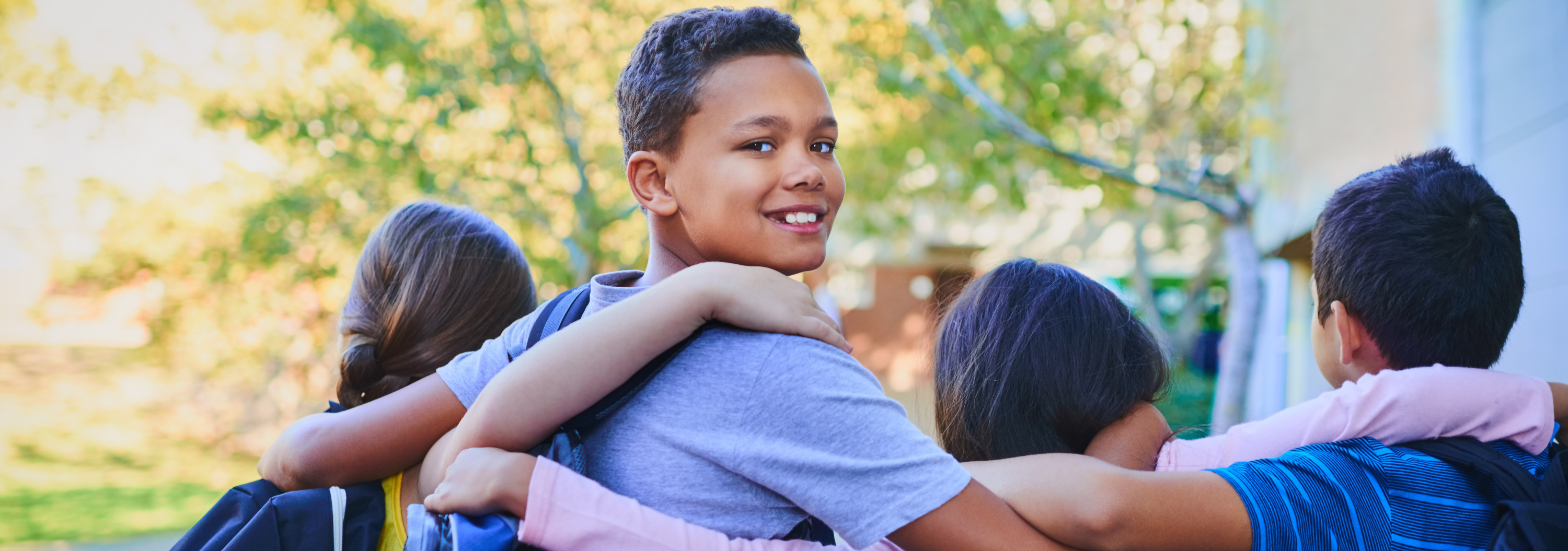School Family Builds Resilience and Empathy
TODAY, WHEN HIS TEACHER ASKED HIM TO ENTER THE CLASSROOM, ISAIAH COLLAPSED ON THE FLOOR, TOOK HIS SHOE OFF AND THREW IT ACROSS THE HALLWAY.
A Really Rough Morning
“I can make a taller one!” Tyler* announced loudly, while eyeing a tower of blocks a group of children was building together. He strode over to the group and forced his way into the circle, oblivious to his peers’ annoyance. “Tyler, stop!” one girl cried, trying to shield the tower from him. He reached past her to grab a handful of blocks, bumping the tower and causing it to topple over.
“You’re so annoying, Tyler! We don’t want to play with you!” came the familiar chorus from his classmates.
Tyler’s experience is a common one for children whose social skills are under-developed. These young people want to connect socially but don’t know how to do so in an appropriate way. Their awkward attempts often frustrate their peers, isolating them further. For Tyler, this was clearly the case. Because he had acted in a similar manner many times before, Tyler’s peers weren’t interested in building a friendship with him. They just found him annoying, which left Tyler feeling alone and frustrated.
In another classroom down the hall, 7-year old Isaiah* was having a rough start to his day. Well, to be fair, Isaiah had been having “a rough start to his day” every day since the he returned to school after the COVID lock down. During the early part of the pandemic, he became accustomed to spending all his time at home with his family. When he returned to school, his separation anxiety had become a serious issue and it was usually at its worst in the morning. He became tearful at the simplest of requests and was always ready for a fight. Today, when his teacher asked him to enter the classroom, Isaiah collapsed on the floor, took his shoe off and threw it across the hallway.
A New Paradigm for the Classroom
At PEP’s Day Treatment Centers, teacher-counselors are skilled at handling tough moments like these. For younger grades, one concept many classrooms use to build competence and empathy is the “School Family.” Part of a larger social emotional learning framework known as Conscious Discipline, the School Family, “builds connections between families and schools, teachers and teachers, teachers and students, and students and students to ensure the optimal development of all.”
As explained by the Conscious Discipline website, “Historically, we have unconsciously used the metaphor of a factory when creating our classrooms and schools. The goal of a factory is to create standardized products through a rewards and punishment paradigm. Research and experience prove that we need a new metaphor if we wish to build successful and safe educational institutions. The School Family, built on a healthy family model, is this new metaphor. The goal of a healthy family is the optimal development of all members.”
Building a School Family at PEP
Ultimately, the goal PEP classrooms are aiming for when creating a School Family is for every child to feel supported and cared for at school, just as they do at home. For children who come from homes where they don’t feel safety, the School Family is especially important. So, how is it done? School Family is more than just a mindset. It is created through routines, rituals, and structures, including the examples described below.
School Family Picture Boards
At the beginning of the year, many classrooms create a “family tree” or picture board and invite students to bring in pictures of their families. These pictures serve as a reminder that their journey at PEP is one that is supported by their family and that the skills that they are working on at home are the same ones they are working on at PEP.
In addition, some PEP Day Treatment Centers create a family tree in the hallway and put pictures of all the teachers and support staff from the building on it. This tree is a reminder that each child is part of a larger community and that there is support for them throughout the building.
Layering in Family Support from Home
For some students, like Isaiah, building a link between home and school is particularly important. There are many ways to do this. Now, when Isaiah gets to school, he has a new routine. Before he does anything else, he sits down with a teacher-counselor and reads a social story that was created for him by his teacher and his mother. The story reminds him of what his family wants for him at school – such as for him to have safe hands. It’s a helpful way for Isaiah to ease into his school day, keeping in mind that his mother loves him and supports him while he is at PEP.
Similarly, some children have pictures of loved ones on their desks with messages that provide support and encouragement. One boy, for instance, has a picture of his mother on his desk with the message, “Mom knows you are a good and smart boy.” The message these connections between home and school convey is that at PEP we want you to feel the same love and support at school as you get at home.
Rituals and Routines
School Families adopt rituals and routines, just like a family at home does. One cherished ritual for many classrooms who use the School Family approach is the birthday party. In these classrooms, each child gets a birthday party with a birthday treat like cupcakes – usually supplied by the teacher-counselors. Not only do these parties make children feel special (more than one child has told us this was the only birthday party they ever had) these celebrations create bonding experiences for the group.
School jobs are another ritual many classrooms adopt to create routines. Jobs help each student understand that they are part of the group and that their contributions are needed to make the group function optimally. Jobs also help children feel competent and gain confidence.
Mindset and Safe Language
There is something very powerful about describing classrooms as a “School Family.” Take Tyler’s blunders at building friendships, for example. When discussing the situation with the other children, we can talk about Tyler being a part of our family. At home, you wouldn’t shun a family member who was annoying you. The same is true at school. That means instead of refusing to play with Tyler, it is our job as his family to help him.
With that frame of mind, in this scenario, we work together to teach Tyler how to ask more appropriately to join a group. With teacher-counselor support, his peers roleplay with him. They pretend to be playing a board game and he practices asking nicely if he can join them. He learns how to approach them and they learn how to help him.
“Safe Language” is the second part of this lesson. Tyler’s peers had the right to be frustrated by his behavior, but they also needed to learn how to communicate with him in a kind manner. One simple way of having kids reflect on their use of language is to ask them, “Is it helpful or is it hurtful?” This doesn’t mean the children can’t say “no” if they don’t want to play with Tyler. They just can’t say no in a hurtful way.
School Family Promotes Resilience and Healing
At PEP, many of our students are facing challenges that make it difficult for them to navigate their days. There are many “Tylers” whose social skills are lagging and there are many “Isaiahs” whose anxiety manifests in challenging behaviors. These young people have experienced a lot of failure in their short lives. They don’t have the confidence that comes from feeling successful. Conscious Discipline strategies like the School Family help us focus on the good. We strive to notice what is going well and that can make a huge difference for children who are so accustomed to feeling like they messed up.
The School Family approach also helps us frame our thinking in a more positive way. Every day, we start fresh in the classroom. Whatever happened yesterday is in the past and today is a new day. Thinking of ourselves as a family helps us build empathy for one another. We care about our family members and focus on how we can all help each other, rather than what everyone is doing wrong. For our kids, so many of whom face unimaginable challenges, having a safe and supportive School Family is a key element in building their resilience and supporting their healing.
*Not their real names.
Contributed by:
 Kristine Verlie, behavior support specialist, PEP Hopewell
Kristine Verlie, behavior support specialist, PEP Hopewell
 Kim Corrado, clinical associate, PEP Hopewell
Kim Corrado, clinical associate, PEP Hopewell
